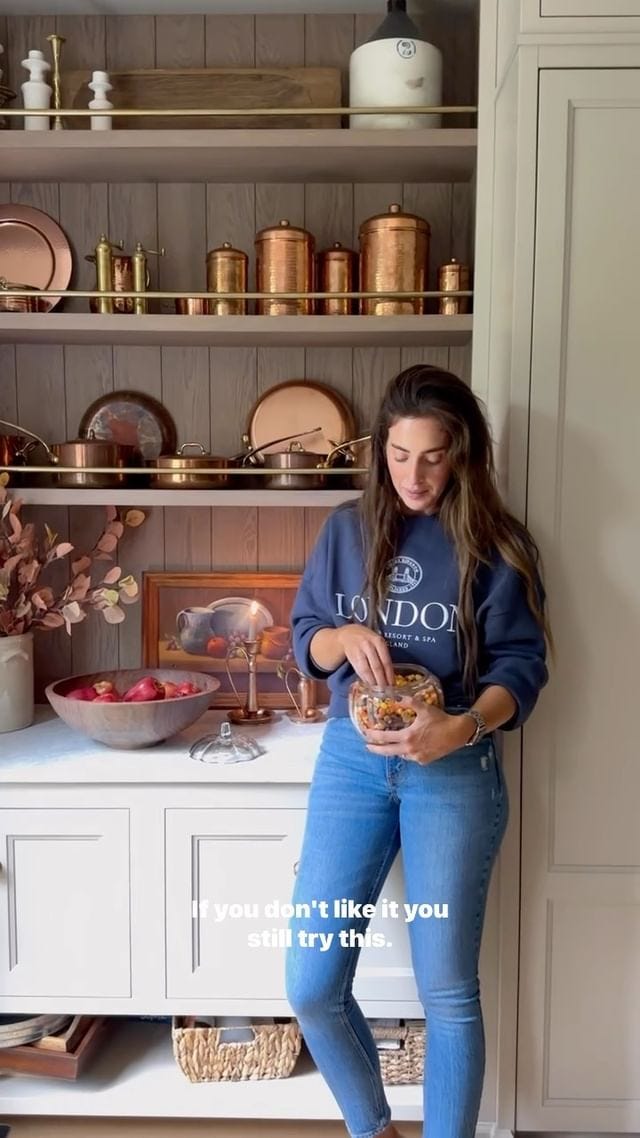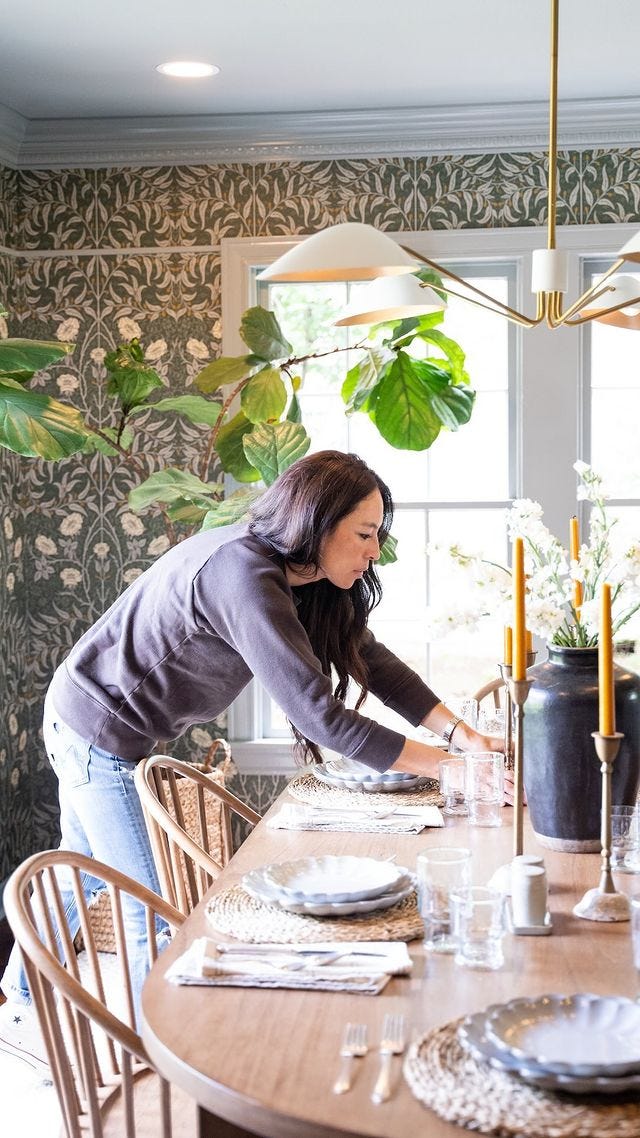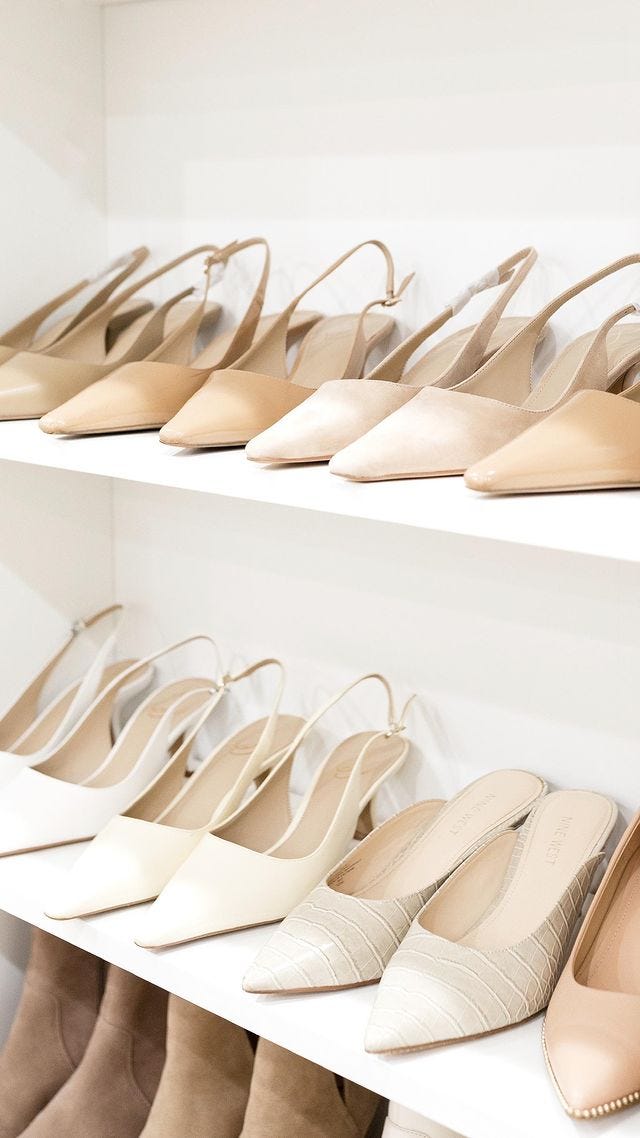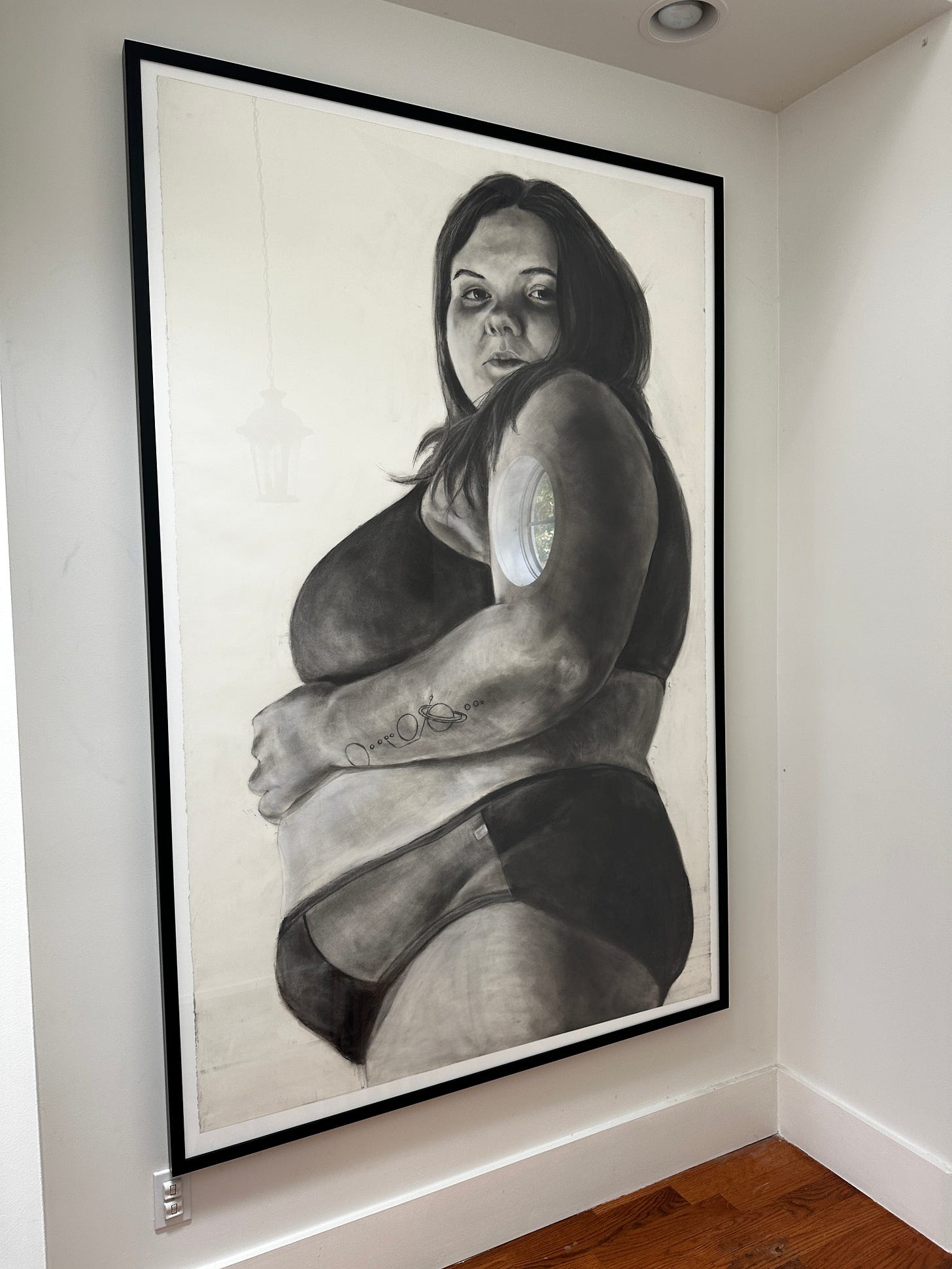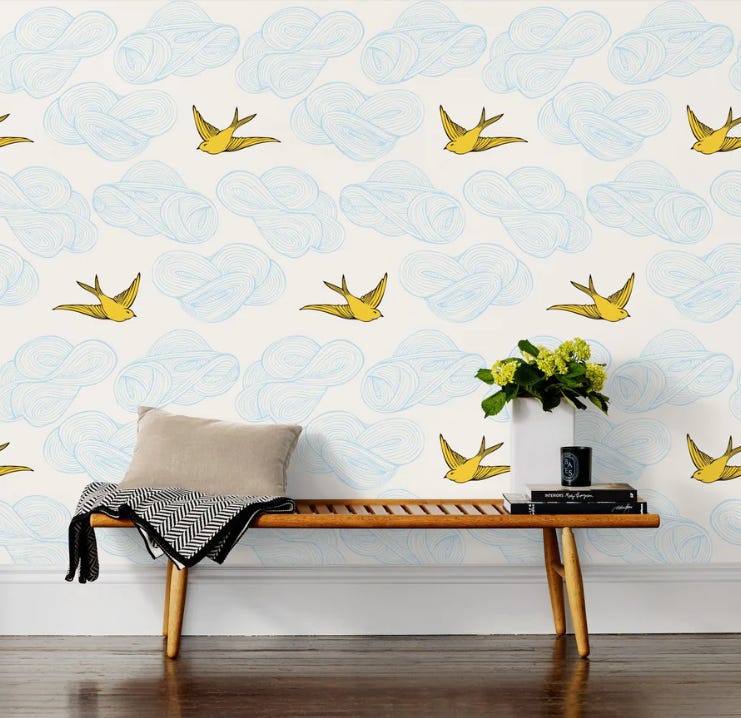A few weeks ago, home influencer and blogger Julia Marcum, of @ChrisLovesJulia fame, posted an Instagram reel called Home Splurges Around Our House We Don’t Regret. The video shows her 1.2 million followers a set of double washers and dryers, double dishwashers, and hundreds of thousands of dollars worth of custom built-in storage, plus her signature, mile-long marble island. It’s worth noting that these are far from the only splurges in the current Marcum house, which also features an outdoor kitchen, a pool, and a guest house with a home gym.
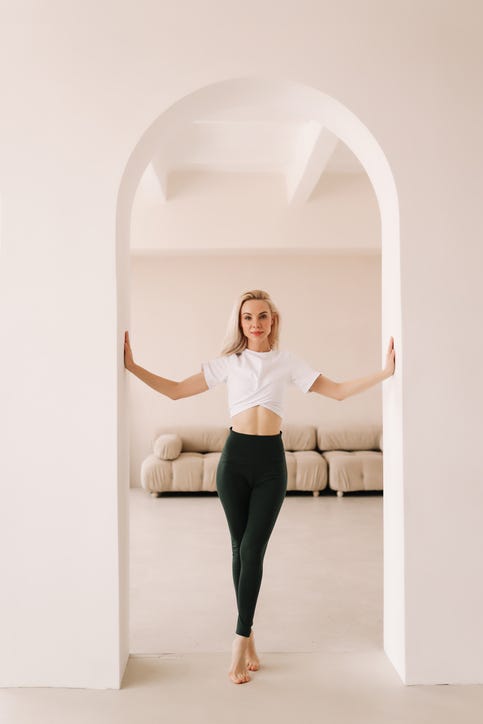
Last week, Julia posted another reel, in which she stands in her impossibly high-end kitchen, holding a jar of homemade autumnal trail mix. “I don’t eat sugar,” Julia says. “And yet, this time of year, I cannot, like, stay away from this.” The recipe: Candy corn, honey roasted nuts, and Reese’s Pieces. “I keep putting the lid on, walking away, and coming back for little handfuls,” she tells us, munching away. “I can’t stop!”
And I can’t stop thinking about this woman, standing in a kitchen with a walk-in pantry, full-size freezer, and a pebble ice machine in her bespoke “beverage center,” while only allowing herself “little handfuls” of candy and nuts.
Julia has talked openly about using food rules to manage various ongoing health issues, and her husband (the Chris who loves Julia) cooks elaborate meals that appear decadent, but conform to her extensive list of restrictions. It’s not about weight per se — both Marcums are tall and straight-sized, and Julia is especially willowy—but it’s not not a diet. Come to ChrisLovesJulia.com to browse Julia’s inspiration boards; stay for the grain-free lemon basil granola recipe.
If you follow @ChrisLovesJulia, Instagram will also invite you to follow @nestingwithgrace, an account with 628,000 followers run by Brooke Christen who posts about renovating her 1970’s Utah home alongside Paleo meal plans, and Emily Henderson, a design blogger with almost a million Instagram followers who is finishing up the Portland farmhouse of my dreams and posts annually about her #Souptember and #JanStewary challenges, where she eats, you guessed it, basically only veggie-heavy soups and stews. Chicago interior designer and HGTV host Tiffany Brooks posts color-drenched interiors alongside her weight loss journey updates, writing “I guess my glow-ups don’t just happen in houses.” And Elsie Larson and Emma Chapman, the sister creators behind A Beautiful Mess have long interspersed their before and after room makeovers with posts about their fitness and weight loss challenges.1
It’s not surprising that home influencers — like momfluencers, beauty influencers, and every other type of influencer— tend to be thin, white, and marketably attractive. Or even that so many of them are on various kinds of diets; these are women socialized in diet culture, for whom extensive public scrutiny about their bodies is a cost of doing business. But the rise of this more explicit diet content in home influencing has made me ponder—as a rabid consumer of home content—how else diet culture shows up here. Are we learning to embrace fluffy autumnal throws and scented candles as a stand-in for the comfort we’re not supposed to get from food? Or is the relentlessness of renovation culture, and the quest to always be perfecting your living space, in and of itself another kind of diet?
The Home Blogger to Lifestyle Guru Pipeline
At one point in my life, I cared much more about fashion than about home design. This made sense when I was a broke teen and 20-something; I could shop for cheap shoes on 8th Street in the Village. I could do much less about the dingy tile in a shoddy studio rental. When I look back over my own trajectory away from Active Dieting, I can see that there were several years, coinciding with gaining weight and having kids, when I had basically no relationship with fashion. I couldn’t wear the same brands anymore. Nothing fit the same way or felt comfortable. I was afraid of taking up space, of being too brightly colored, too loud, too much. And what replaced fashion, for me, was home design.
I suspect I’m far from alone here. When you’re the fat friend who can’t fit into the clothes at Anthropologie or Urban Outfitters, it’s helpful that you can go browse happily in housewares. Plus I’ve never not been interested in pretty house stuff. I was a dollhouse-obsessed kid who redecorated her bedroom every year; who packed fairly elaborate (Ikea-sourced and DIY’ed) decor for her college dorm rooms before over the top dorm room decor was thing. I’ve nested hard in every apartment and house I’ve ever lived in, to whatever extent my budget has allowed, and often beyond. I became a first-time homeowner in 2009, at the dawn of the home design blog era, and immediately turned into a voracious consumer of just so much home and DIY content: YoungHouseLove2, Bower Power, Design Mom, Emily Henderson, A Beautiful Mess, ChrisLovesJulia… the list obviously goes on and on. These were my first and deepest parasocial loves; the blogs I read as soon as their posts popped up on my Google Reader.
And for a long time, I thought of the home thing as a passion that existed quite separately from anything to do with diet culture. If anything, it felt like a break from that world. I wasn’t thinking about my body when I was buying cute throw pillows or pinning inspiration for a farmhouse bathroom renovation. I knew nothing about how any of these influencers ate or exercised. I was just there to decide if I loved or hated their bold new floor color; if I could replicate their gallery wall of family photos; if I could use their thrifting tips to find more vintage cake stands for my collection.
But somewhere along the way, home influencers started to move away from (admittedly labor-intensive) DIY projects, into higher-end renovations with contractors, subcontractors, and big sponsors as well as into so much more general lifestyle content. And then they started to tell us quite a lot about their diets.
In trying to pinpoint what changed, we must, of course, consider Joanne Gaines, patron saint of home influencing. As I wrote for Curbed in 2016, Joanna has never been just an interior designer:
When HGTV Magazine documented an obviously simplified “day in the life” of the Gaines family, it revealed that Joanna functions on less than six hours of sleep a night, drinks 125 ounces of water each day, and saves time by washing her hair before bed, “so in the morning I only have to curl it.” This frees her up to cook biscuits and gravy for the family’s breakfast. None of which offers much in the way of an empowering blueprint for living the modern work/life balance dream. This domestic goddess myth is strangely at odds with the low-key likability that draws so many fans to the show. If we’re charmed by Chip modeling his dad bod, why do we need Joanna in size zero skinny jeans?
And our fascination with Joanna as a domestic goddess, and as a hot mom, was quickly folded into the Magnolia brand. Here is Country Living (of all titles!) breathlessly reporting what Joanna eats in a day in 2018, years before TikTok made that a hashtag. In 2021, she launched her own cooking show. From there, we can trace a fairly direct line to the more recent surge of home influencers crossing over to be food and diet influencers (and sometimes fitness influencers: Any regular Julia Marcum follower knows she hits the gym first thing in the morning while Chris gets the kids up for school). It is not enough to tile a bathroom well. Home design influencers must also be lifestyle gurus, which means sharing their favorite clothes and beauty products and smoothie recipes.
The Domestic Abundance Diet
So this is part logical response to the demands of social media. But there is an inherent diet mentality to the pursuit of home renovation itself. Every major home influencer has now graduated from their budget “we made this reclaimed barn wood accent wall ourselves!” days to bigger houses, bigger projects and far more luxe finishes. They are designing and styling now, not just DIY-ing. And that’s because the bar on what a pretty house needs to look like to perform on the Internet keeps rising. If we can never be thin enough for diet culture, we can never have enough clever cabinet hacks, enough beautifully styled shelves, enough marble countertops but with this year’s edge detail. There is a rigidity to these standards and how they fuel a need to always be working on your home the way we’re also told to work on our bodies. But there is also an abundance to them that makes sense when we consider how diet culture constrains these influencers, and all of us, in so many other ways.
It’s no coincidence that so many home influencers are members of religions with strict gender norms and rules. Joanna and Chip Gaines have had to navigate pushback to their longtime affiliation with the Antioch Community Church, an evangelical megachurch in Waco, Texas led by Senior Pastor Jimmy Seibert, which condemns same-sex marriage and supports a local pro-life pregnancy center. As I wrote for Curbed: “While[Antioch] states on its official Beliefs page that ‘the husband and wife are of equal worth before God,’ it quickly clarifies that ‘a wife is to submit herself graciously to the servant leadership of her husband … [and] has the God-given responsibility to respect her husband and to serve as his companion in managing the household and nurturing the next generation.’” Katie Bower, of @BowerPowerBlog identifies on Instagram as “5 kids/love Jesus.” Julia and Chris Marcum are members of the Church of Latter Day Saints. Emily Henderson was also raised Mormon (and has written about why so many Mormons and ex-Mormons are bloggers) but left as a teenager (she has recently written about returning to a much more liberal church). Emma Chapman and Elsie Larson have also spoken about their evangelical upbringing.
None of these influencers are #tradwives. In every popular husband-and-wife design duo, the wife is always the beauty and the talent; the Joanna to his Chip. Conservative religious home influencers are pro-Prosperity Gospel and comfortable nailing down big sponsors and making big money (to pay for their big houses). But they are also performing an intensely domestic life that meets many exacting cultural norms. It makes sense that when we tell women their lives and ambitions should be confined to domestic spaces, that they want to make those spaces as big and overflowing as possible.
Are there any home influencers in bigger bodies? I’ve only found two with significant followings. Nabela Noor Martin is a beauty YouTuber turned “designer, author and homemaker” with 2.5 million followers and an impeccable all-white mansion in which she recently showed off a bedroom-sized custom closet filled with designer clothes, shoes and bags. Nabela has written a body positive children’s book and regularly claps back against anti-fat trolls, but also performs a level of aesthetic perfection that no mere mortal—and certainly not one with two babies under age 2—could ever hope to achieve. Justina Blakeney, founder of now-in-Target Jungalow, has almost 2 million followers between her brand and personal accounts where she posts gorgeous shots of her colorful, eclectic, wildly patterned home designs and wardrobe and, in the past year or so, an increasing number of full body swimsuit shots documenting her quest to lower her cholesterol and manage her IBS by “listening to her body.” Again, it’s not not a diet. For women at home, it seems that abundance must be accompanied by some kind of control.
Taking Up Space
I am excited about the rise of less conventional voices in the home influencing space, which we can find when we look beyond the huge follower counts. Corinne introduced me to Kellie B of deeplymadlymodern, who just posted about her big fat bedroom, and talks about choosing a sofa that feels solid and comfy for her body. (I mean, thank goodness one home influencer is thinking about WELL-DESIGNED fat-friendly and otherwise accessible seating!!) I also love Medina Grillo, who focuses on highe end design for renters. If you’ve got other marginalized/less traditional design folks to follow, please drop them in the comments. Because it’s exhausting that this is yet another content vertical we have to curate to get the anti-fatness out—but exciting that perhaps this is starting to feel more possible even as the mainstream influencers get bigger kitchens and smaller bodies.
I found escape in home renovation culture for a long time because there is so much you can reasonably and pretty safely try to control there. When my body felt “wrong,” my house could be “right.” Except when it couldn’t because budget, because time, because perfectionistic standards about what homes should look like can so profoundly get in the way of our ability to live and be a family in them. Still, I don’t intend to divest from home culture completely. In the past few years, I’ve made friends(ish) with fashion again and no longer try to pretend my body just doesn’t exist. But oh goodness, I have all kinds of plans and dreams for my house right now. Last week, I had an eight foot tall Lindsey Guile drawing of my friend Hannah hung in our stairwell. The drawing was a gift from Dan, to celebrate FAT TALK becoming a NYT bestseller. I paid to have it framed and carefully installed as a gift to myself, because this has been a year and I’m craving beauty right now. And because the drawing takes up so much space and I need my home to be a place where my girls and I can exhale and expand, and not apologize for ourselves in any way.
Am I being a bit of a snob to imply a piece of high-end art accomplishes that better than a marble countertop? Yes. Does a part of me want marble countertops anyway, some day? Yes. (I mean maybe no? They stain and scratch so easily? Still also, yes.) Untangling our appetites from consumerism will always be a messy business. Entire industries profit by training us to think of both bodies and houses as perpetual fixer upper projects. There will always be more projects to do and more throw pillows to buy. But we know diets fail because restriction breeds fixation. So maybe it’s helpful not to try to force ourselves to stop wanting, whether we want the Marcums’ fancy kitchen or Elsie Larson’s hidden library, or just everything in Target’s Studio McGee fall line-up. Instead we can just get curious about what underlying deprivation or expectations might be fueling those big wants. And consider what it would feel like to release those rules. Or to have those needs fulfilled.
The Cute Home Shit I’m Craving Right Now
So while we’re unpacking what’s underneath our big house wants… here’s some house stuff I’ve been wanting lately! I’m employing a Pinterest Board strategy with house cravings right now too, and absolutely do not expect to buy all of these or even most. But am I here to enable a little stress shopping if you need it? Sure am! (As a reminder, none of this is sponsored and I don’t use affiliate links.)




